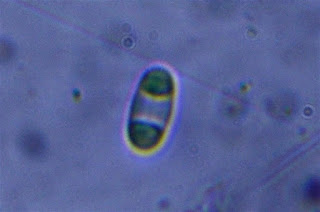I've had to put this lichen down as Opegrapha sp. as it doesn't key out. I've put the information here so it can be referenced in the future should I get more information regarding missing species in current literature. Closest match would be O.vulgata but what looks like pycnidia is in fact the early stages of new lirellate.
Lirellate 1mm
Thallus endolithic with a greenish tint
No pycnidia, only newly formed lirellate resembling pycnidia.
Spores 5-septate 22x5µm
Ascus 42x12µm
Generic Key 5 p.57
True exciple present
Ascospore septate
Ascospore multiseptate
Ascospore lumina cuboid
Ascospore colourless
Lateral exciple in section brown-black
= Opegrapha or Lecanographa
Opegrapha key:
Photobiont present (not lichenicolous)
Thallus without soredia, apothecia present
Ascospore 5-septate
Apothecia disc remaining slit like
Ascospore 4-7 septate
On bark
Ascospore 4-9µm wide
Key end, no match.
Opegrapha's characteristics:
O.anomea - On Pertusaria amara
O.areniseda - Mainly coastal on soil and sand
O.atra - Clearly defined mosaic forming patches
O.brevis - On Thelotrema petractoides
O.calcarea - On rock
O.cesareensis - Coastal siliceous rocks
O.corticola - Sterile
O.demutata - White pruina
O.dolomitica - On calcareous schists
O.fumosa - Sterile
O.glaucomaria - On Lecanora rupicola
O.gyrocarpa - On siliceous rock
O.herbarum - Slit opening wide when mature
O.mougeotii - Limestone, mortar, calcareous sandstone
O.multipuncta - On small branches
O.niveoatra - Often sterile
O.ochrocheila - K+ magenta-red
O.parastica - On Aspicilia calcarea
O.paraxanthodes - Mainly upland deeply shaded rocks
O.pertusariicola - On Pertusaria leioplaca
O.physciaria - On Xanthoria parietina
O.prosodea - 50-70µm ascospores
O.pulvinata - On Dermatocarpon miniatum
O.rotunda - On Physconia distorta
O.rufescens - Apothecia .3 to .5mm
O.rupestris - On V.baldensis
O.saxigena - Deeply shaded siliceous rock
O.sorediifera - Sterile
O.sphaerophoricola - On Sphaerophorus globosus
O.subelevata - On limestone, mortar and sandstone
O.thelotrematis - On Thelotrema lepadinum
O.trochodes - Apothecia 0.15-0.4mm
O.varia -
O.vermicellifera - Similar to Lecanactis subabietina
O.viridis -
O.vulgata -
O.xerica -
O.zonata - Shaded siliceous rocks
O.zwackhii - On Phlyctis argena











